


Welcome to Mudley Token Documentation ! The Get Started guide will introduce you to the basic technical aspects of Mudley token, starting with an introduction to the various parts of the Mudley token:

If you’re new to Blockchain and want to get an overview, this is where to start !
Mudley token introduction.
Intro to Stellar because Mudley token is built on a Stellar Network !
Let introduce our AI !
How to get Surprise Rewards ?
Do you want to trading Mudley token ?
If you have been following banking, investing or cryptocurrency over the last ten years, you may be familiar with "blockchain" the record-keeping technology behind all crypto currency network.
The goal of blockchain is to allow digital information to be recorded and distributed, but not edited. Yes blockchain is a write-only database !
However, while a blockchain is a database, a database is not a blockchain. They are not interchangeable in a sense that though they both store information, they differ in design. There is also a difference in purpose between the two.
A blockchain stores information in uniformly sized blocks. Each block contains the hashed information from the previous block to provide cryptographic security. The hashing uses SHA256 which is a one-way hash function. This hashed information is the data and digital signature from the previous block, and the hashes of previous blocks that go back to the very first block produced in the blockchain called a “genesis block”. That information is run through a hash function that then points to the address of the previous block. A blockchain data structure is an example of a Merkle Tree, which is used as an efficient way to verify data.
Investing or trading in cryptocurrencies you need to get a crypto wallet and deposit money into an exchange to buy different cryptos. You can be intimidating at first. There is frequently news about scams and people losing money. While this is true, and many scams have happened and continue to happen, it has never been so simple to invest in cryptocurrency. So much has advanced in the last few years that have made crypto trading safe and easy.
This list covers the best exchanges for certain types of traders as well as the best exchanges within each type of exchange. There are a number of ways to go about investing in cryptocurrencies. Once you have decided on an exchange, it is important also to practice safe storage. You can see the best storage methods on our **recommend** wallets article.
Mudley token is built on a Stellar Network. As an activity-based token, supply of the token will increase every month from user’s specified activities.
Mudley token currently limit the supply to 300,000 token.
Mudley token has Stellar Lumen ( XLM ) as a backed asset. For every 1 Mudley token created, 1 XLM will be bought in as a reserve.
Another 1 XLM will be transferred to our proprietary artificial intelligence trading system called the Kid Box AI. Surprise Rewards will be created by the Kid Box AI and paid to token holders in a form of major cryptocurrency.
After our supply reaches 300000, we have converted XML as an asset back to store in the form of classical financial assets such as gold and various instruments.
Mudley token introduces a new concept of Surprise Rewards. Mudley token have Mudley’s proprietary artificial intelligence system called the Kid Box AI. Kid Box AI working in a capitalist system to produce Surprise Rewards to token holders. Surprise Rewards will be paid in the form of major cryptocurrency eg. XLM, XRP, BTC, ETH through user’s register wallet.
Mudley token also introduces the concept of No Initial Coin Offerings (No ICO). ICO is like raising fund concept, it’s a good structure and suitable for start-up. But we saw some fragile in ICO, because ICO need money in fiat currency and convert it to cryptocurrency. This structure is sensitive to money scamming and ICO need to be control under fiat currency laws and regulations.
The token’s infrastructure was designed as follows:
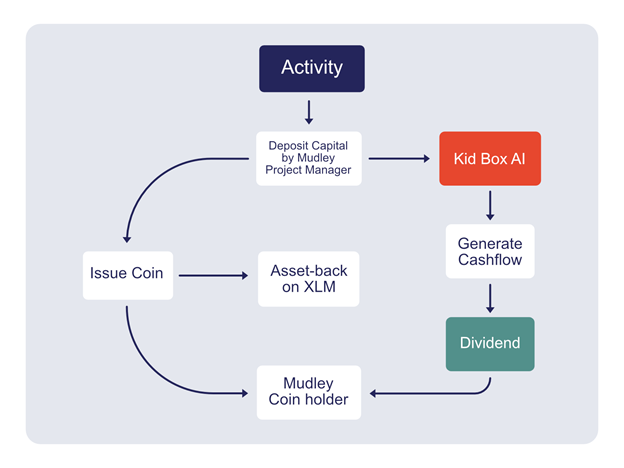
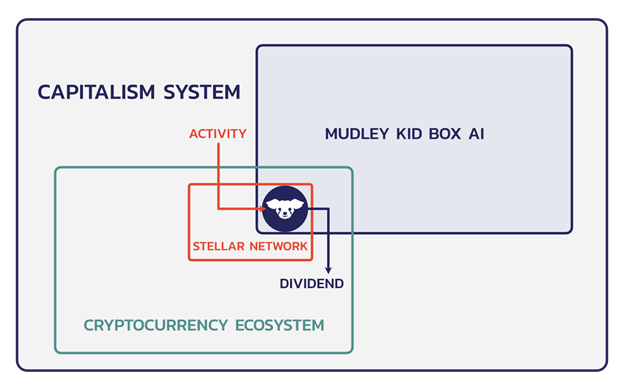
Stellar is a real-time global online platform that supports currency operations. It was founded in 2014 by Jed McCaleb the person behind the famous Mt. Gox exchange / co-founded Ripple, where he was the CTO with Joyce Kim (who has also worked in Ripple with Jed before).
Stellar was initially designed on the Ripple protocol, so basically it can be seen as an offshoot of Ripple’s activity, as the source code of Stellar was based initially on the Ripple platform. Later, in 2015, the open-source protocol Stellar (with its own open-source code) has been developed.
Lumens (XLM) are the native currency of the network.
Stellar is relatively inexpensive and fast.
In addition to being open source. Stellar is highly scalable and can process thousands of transactions per second.
Stellar Consensus Protocol can process the exchange not only of fiat currencies and cryptocurrencies but also of coins/tokens and many other types of assets.
Stellar is like an open source and decentralized version of Ripple.
Ripple was and is still being heavily criticized for its enormous degree of centralization for the blockchain project.
Furthermore, Ripple’s code is not open source, although XRP Ledger was built on the Rippled source and is open source.
Stellar assets, known as tokens, can be used for representing value for nearly anything: US dollars, Euros, bitcoin, stocks, precious metals, Mudley token, ICO tokens or just about anything you like.
there are a lot of different tokens already issued on the network. You can buy and hold tokens redeemable for most of the popular cryptocurrencies, such as Ether, or real-world funds such as Chinese Yuan.
This ability to send and receive many varied types of tokens brings flexibility to the Stellar Network and is one of the most powerful features.
All assets issued on the network (with the exception of lumens) have
Entities that issue assets are called anchors. Anchors can be run by individuals, small businesses, local communities, nonprofits, organizations, etc. Any financial institution can also be an anchor and issue assets. Each anchor has an issuing account from which it issues the asset.
Several types of assets exist on the Stellar network:
Lumens (XLM) are the native currency of the network. A lumen is the only asset type that can be used on the Stellar network that doesn’t require an issuer or a trustline. Any account on the network can hold lumens.
These are assets that were initially created on the network and don’t represent any assets outside of the network.
For example, Mudley token is non-anchored asset, also referred to as native token.
If an asset did not originate on the network, it is anchored on the network by an anchoring entity or anchor. For example, USD or bitcoin tokens issued on the network represent anchored (or tethered) assets.
To receive or hold an asset issued by an anchor in your Stellar account, you must establish (or create) a trustline to that anchor’s account first. By doing that, you signify that you trust the issuer to properly redeem its credit. Trustlines also protect you from having random and unwanted assets sent to you.
Every asset you add to your Stellar account (or equally every trustline you establish) adds 0.5 XLM to your network reserve (minimum balance).
Hello to the Kid Box AI the most secret part of our token. The Kid Box AI is an artificial intelligence trading system that automatic generates Surprise Rewards for Mudley token holders.
In addition to reserving XLM as a backed asset, some XLM will also be sent to the Kid Box AI to invest in financial market.
Getting a Surprise Rewards from Mudley token requires two things.
The Surprise Rewards will now be paid as a Stellar XLM.
We choose to pay Surprise Rewards in the form of Major Cryptocurrencies. Not paid out in our own mudley token.
Surprise Rewards from our Kid Box AI will be distributed in the form of Major Cryptocurrencies.
Past Surprise Rewards performance is on our website See Past Performance !
You can start trading Mudley token on the Stellar Decentralized Exchange
Stellar DEX are places where people buy and sell Mudley token and multiple assets from Stellar network.
Stellar DEX service like Stellar X, Stellar Term is just a graphical user interface that sits atop the Stellar blockchain, and they hold none of your user account’s access credentials (account information, public key, secret key) nor custody any of your assets. You are always directly in control of your coins and you conduct transactions directly with whoever wants to buy or sell your coins.
Stellar decentralized exchanges as opposed to regular top crypto exchanges normally have an order book with lower liquidity than the regular top crypto exchanges.
You can login to Stellar DEX service like Stellar Term by your Stellar wallet. Some services like Stellar X is required you to create new Stellar wallet with them.
Stellar DEX does not accept deposits of fiat currencies. Accordingly, new crypto investors without prior holdings of cryptocurrencies cannot trade at Stellar DEX. If you don’t have any crypto but want to start trading here, you will first have to purchase cryptocurrencies from another exchange and then, as a second step, deposit them to your Stellar wallet.
Stellar DEX trading fees is 0.00001 XLM
Decentralized exchanges are still a minority on the cryptocurrency exchange market, with the centralized exchanges still dominating the field (mostly due to better liquidity).
You can start trading Mudley token by following these steps:
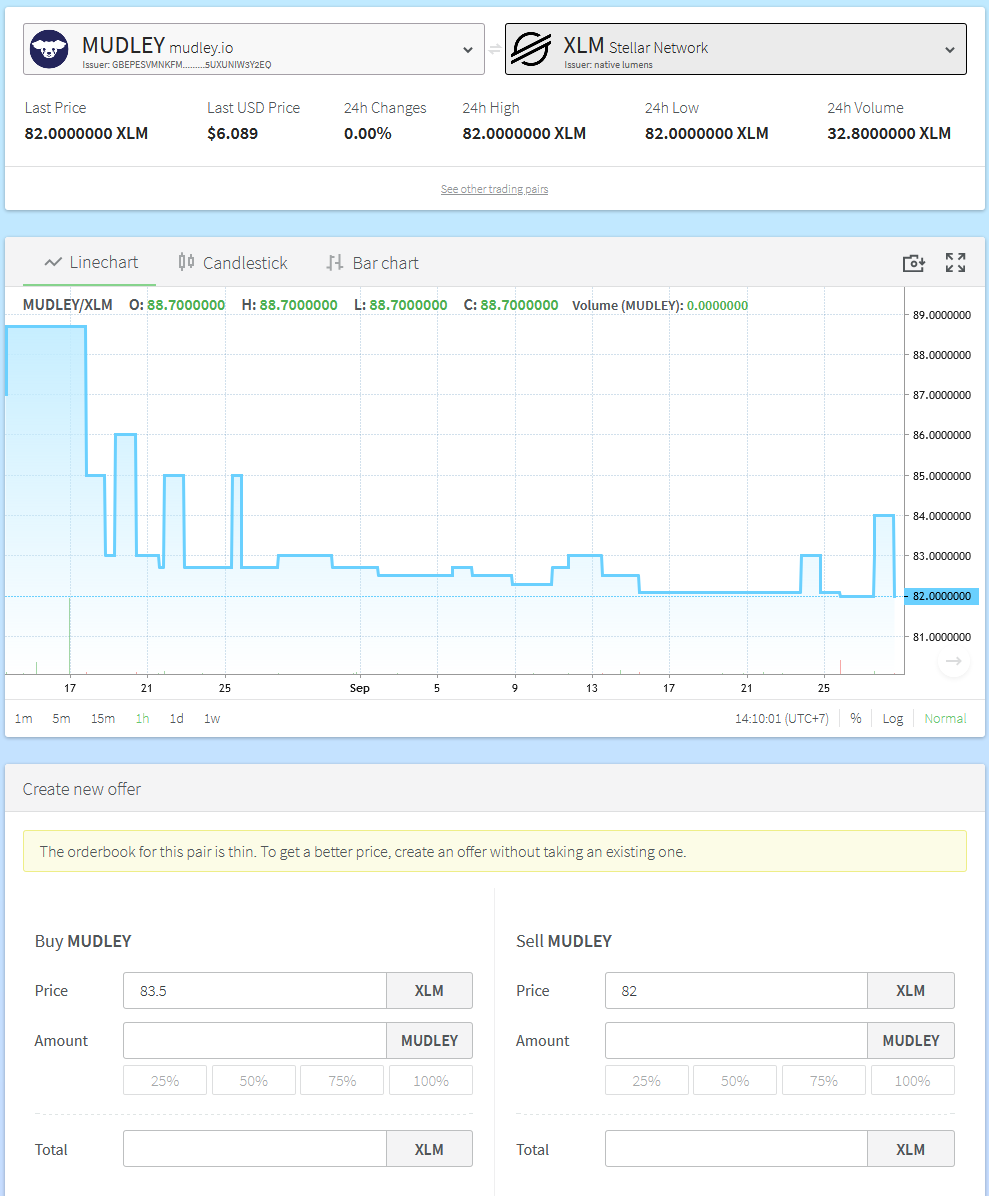
Let’s continue to break down some of the confusing terms and statistics you’ll encounter on most of crypto exchanges:
The complete list of buy orders and sell orders are listed in the market’s order book, which can be viewed on the trading platform. The buy orders are called bids, since people are bidding on the prices to buy Mudley token. The sell orders are called asks, since they show the asking price that the sellers request.
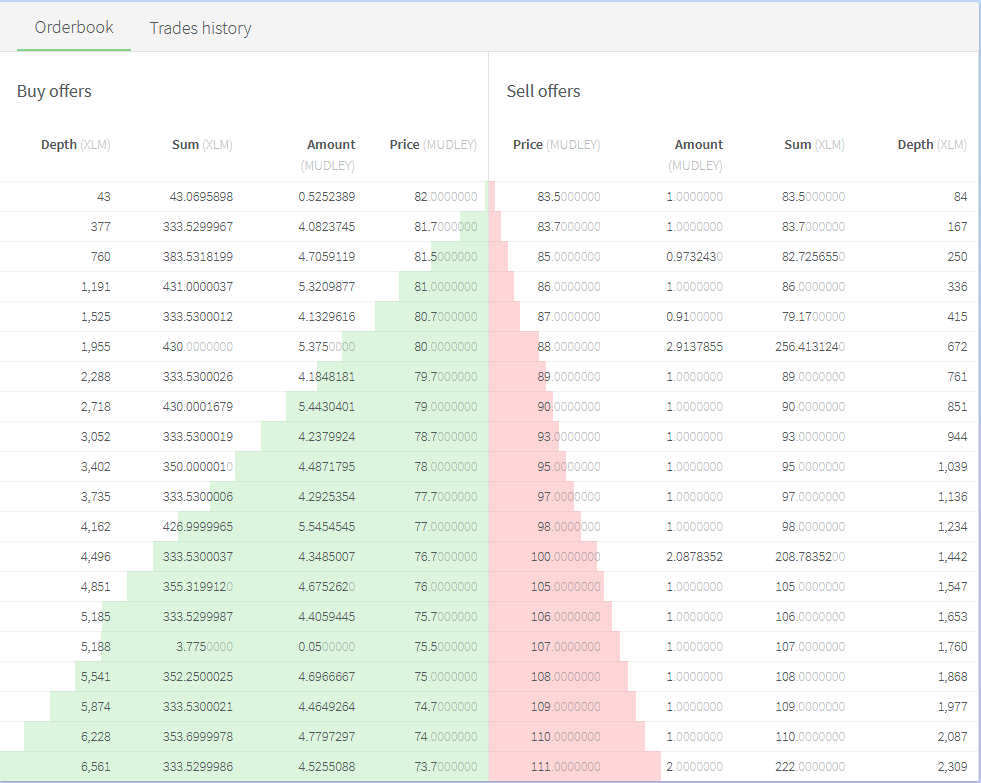
Whenever people refer to cryptocurrency “price”, they are actually referring to the price of the last trade conducted on a specific trading platform. This important distinction occurs because, unlike US dollars for example, there is no single, global cryptocurrency price that everyone follows.
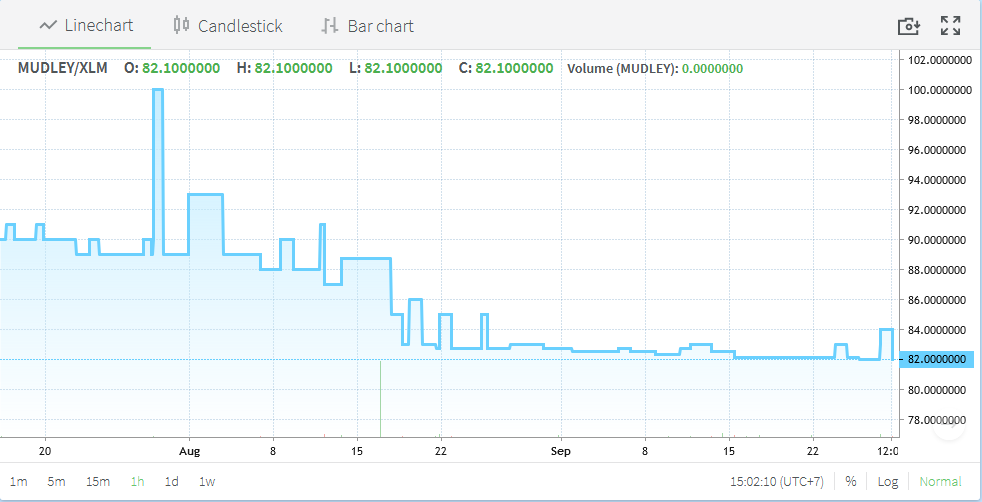
Volume stands for the number of overall Mudley token that have been traded in a given timeframe. Volume is used by traders to identify how significant a trend is; significant trends are usually accompanied by large trading volumes, while weak trends are accompanied by low volumes.
If you are witnessing a sudden change of direction in the price, we recommend checking how significant trading volume is, in order to determine if it’s just a minor correction or the beginning of an opposite trend.
This type of order can be set on a trading platform and it will be instantly fulfilled at any possible price. You only set the amount of token you wish to buy or sell and order the exchange to execute it immediately.
Once the order is placed, there is a good chance that your order will not be matched by a single buyer or seller, but rather by multiple people, at different prices.
in a market order, you don’t stop buying or selling until the amount requested is reached. With market orders, you may end up paying more or selling for less than you intended, so be careful.
Limit order allows you to buy or sell token at a specific price that you decide on. In other words, the order may not be entirely fulfilled, since there won’t be enough buyers or sellers to meet your requirements.